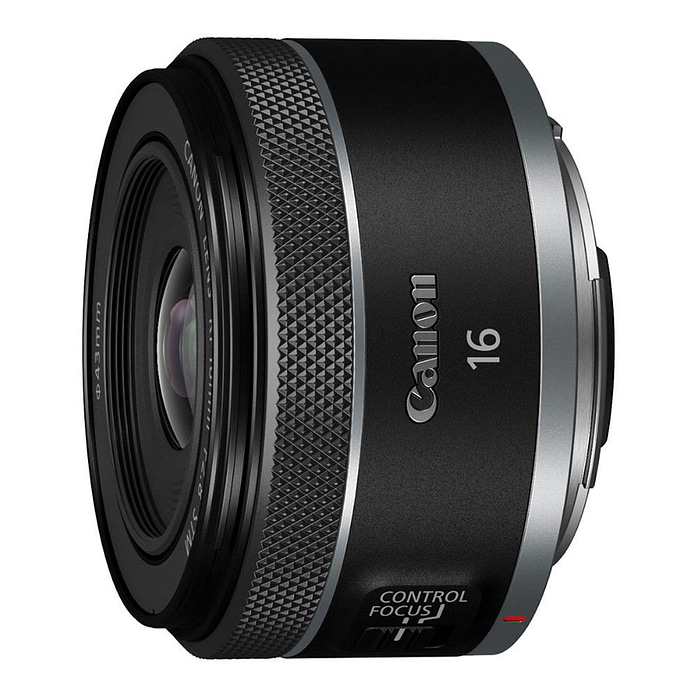The Canon RF 16mm f/2.8 is a tiny lens – almost a pancake – that can be thrown in your bag or jacket pocket while still covering full-frame! At $300, it’s a very exciting option that seems tailor-made to pair with a midrange zoom. But how does the Canon RF 16mm f/2.8 actually perform? This review will answer all your questions!
For years, I had hoped to see Canon, Nikon, or Sony release a lens like this. It felt like a neglected area of the lens market: an ultra-wide, full-frame lens that prioritized price and size. Sure, I like 16-35mm f/2.8 zooms and 20mm f/1.8 primes as much as the next photographer – but for context, the Canon RF 16mm f/2.8 is less than half the size and less than half the price of any of them.
As someone who does a lot of backcountry hiking and photography, it feels like a dream come true to carry an ultra-wide lens that’s so small and portable that I forget it’s even on my camera. That’s why I had a really enjoyable time shooting with the Canon RF 16mm f/2.8 during my time with it. There’s a lot to be said for keeping a small, cheap lens like this one in your bag any time that you need to leave a bigger ultra-wide lens at home.
Unfortunately, my impressions of the lens weren’t all positive – in fact, mostly the opposite. As you’ll see on the “Optical Performance” page in a minute, the Canon RF 16mm f/2.8 has some serious issues that make it a hard lens to recommend for a number of reasons. It could still be a reasonable choice for long-distance hikes or fast-paced travel photography, but it’s definitely not the diamond in the rough that I had hoped to find.
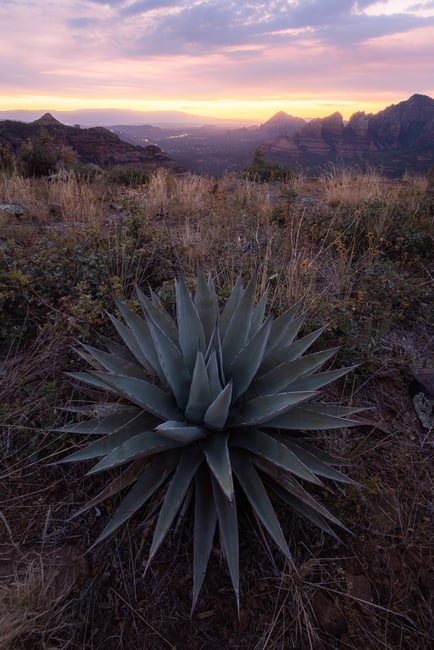
Canon RF 16mm f/2.8 Specifications
- Full Name: Canon RF 16mm f/2.8 STM
- Mount Type: Canon RF Mount
- Focal Length: 16mm prime
- Angle of View (Full Frame): 108° 10′
- Maximum Aperture: f/2.8
- Minimum Aperture: f/22
- Aperture Blades: 7, rounded
- Filter Size: 43mm
- Lens Elements: 9
- Lens Groups: 7
- Special Elements: 1 aspherical
- Anti-Reflection Coatings: Super Spectra Coating
- Fluorine Coated Front Element: No
- Image Stabilization: No
- Internal Focusing: No
- Control Rings: One (for both focus and custom control)
- Function Button: No
- Switches: Manual focus / custom control ring
- Focus Motor: STM
- Minimum Focus Distance: 13 cm (5.1 inches)
- Maximum Magnification: 0.26× (1:3.8)
- Mount Material: Metal
- Weather/Dust Sealing: No
- Dimensions (Length × Diameter): 40 × 69 mm (1.6 × 2.7 inches)
- Weight: 165 g (0.36 lbs)
- MSRP: $300, with sales of $250 seen (check current price)
These specs aren’t especially high-end, but for a $300 lens, it’s totally acceptable. Also, the metal lens mount is something of a surprise for an inexpensive, lightweight lens like this.
Probably the signature feature of the Canon RF 16mm f/2.8 is the weight of 165 grams / 0.36 pounds – and the correspondingly small size, just 4 cm / 1.6 inches long. This is a truly portable lens that you can take along with you almost anywhere.

Build Quality
Although the Canon RF 16mm f/2.8 is an inexpensive lens, the quality of the plastic itself feels the same as expensive lenses like the Canon 15-35mm f/2.8 L side-by-side. I have no issue with the lens’s use of high-quality plastics for the main barrel. However, the RF 16mm f/2.8 is not weather sealed – which might not be a major problem in itself, but it’s a bad combination with an externally-focus lens.

To me, this makes the Canon RF 16mm f/2.8 a less appealing choice for shooting in difficult weather conditions, especially rain. I was still willing to use my copy of the 16mm f/2.8 in a light drizzle, but I wasn’t confident that it could withstand a serious rainstorm, unlike some of Canon’s RF lenses. Also, the moving part of the lens feels like it was made of a lower-quality type of plastic than the rest of the barrel.
My final issue with the lens’s build quality is the lens hood – or, rather, the lack of lens hood. Canon doesn’t supply one with the RF 16mm f/2.8, so if you want a lens hood, you’ll need to spring for the separate EW-65C at $40. At least the lens hood doesn’t attach to the moving portion of the barrel, but this is still a disappointing exclusion on Canon’s part.

Handling
The Canon RF 16mm f/2.8 handles about as expected for a pancake lens, and I won’t hold that against it. As you can see, there’s not a lot of room on the lens for other controls:

Something interesting about the lens’s handling is that the traditional autofocus/manual focus switch has been changed to a switch that says “control” and “focus.” It’s a pretty clever design, in my opinion. When set to “focus,” you can use the ring on the front of the lens to adjust manual focus. However, when set to “control,” the front dial now does whatever you’ve programmed it to do in Canon’s menu, such as changing aperture or exposure compensation.
One thing to note is that, unless the camera itself is set to manual focus, you have to press the shutter button halfway (not hold it; you can let go after a moment) before you can manually focus the lens. That part is something that I don’t love about the lens’s handling, although it’s something I got used to doing pretty quickly.

Focus Speed and Performance
The Canon RF 16mm f/2.8 autofocuses quickly and accurately. This isn’t a surprise considering that ultra-wide lenses usually have more room for error (and less focus throw in general) compared to longer lenses, but it’s still welcome. There is some noise from the STM focusing motor, so video shooters may be better off with a lav mic rather than an on-camera shotgun mic.
Because of the f/2.8 maximum aperture, the Canon RF 16mm f/2.8 focuses well in dark conditions. Relative to an f/4 lens like the Canon RF 14-35mm f/4 L, you can focus with the 16mm f/2.8 if there’s half as much ambient light. The lens even has a pretty high maximum magnification of 0.26x, allowing for some interesting ultra-wide closeups and/or very near foregrounds without issue.

Distortion
This is where things start to look bad. The Canon RF 16mm f/2.8 has extreme levels of distortion: -11.71% barrel distortion by our tests! This is approaching fisheye level – in fact, I believe it sets a new record among all the non-fisheye lenses that we’ve tested.
Here’s a simulation of -11.71% barrel distortion on a flat grid:
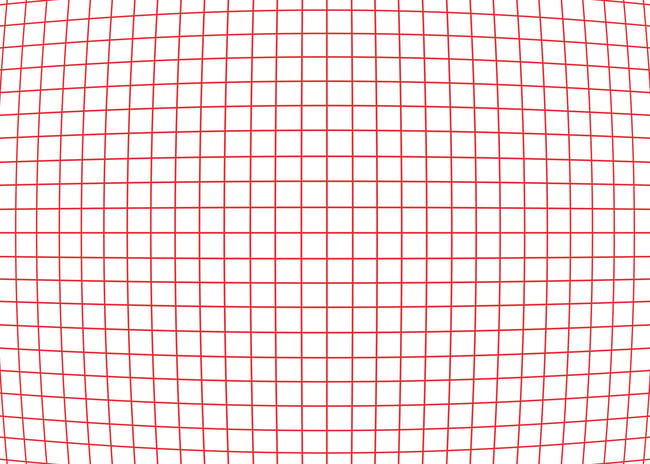
A lens with this much distortion simply wouldn’t have been acceptable in the film days, but thanks to digital corrections, many photographers who shoot with the RF 16mm f/2.8 will never even notice how bad the distortion gets. Most post-processing software has corrections turned on by default, and if you shoot JPEG, Canon doesn’t even let you turn off the distortion corrections when you’re using this lens.
Unfortunately, correcting distortion to such a degree will inevitably stretch the pixels in your photo, especially in the corners, making them less sharp.
On the positive side, I’m happy to report that the Canon RF 16mm f/2.8 is a 16mm lens after the distortion has been fixed. Before corrections, it’s about as wide as a 15mm lens.
Vignetting
Where vignetting is concerned, this lens is extremely interesting. In photos where the distortion has not been corrected, the very tips of the corners are essentially black at f/2.8, as if there’s mechanical vignetting from a thick filter. Measuring this vignetting using our usual method in the lab is simply not productive, because you get measurements that show 10+ stops of vignetting.
However, like I said in the distortion section, the Canon RF 16mm f/2.8 simply isn’t meant to be used without fixing the distortion. Once the distortion is corrected, the dark tips of the corners are no longer shown in the photo, and the vignetting returns to reasonable territory. It’s still high, don’t get me wrong, but not unheard of. Here’s a full chart of our measurements, post distortion correction:
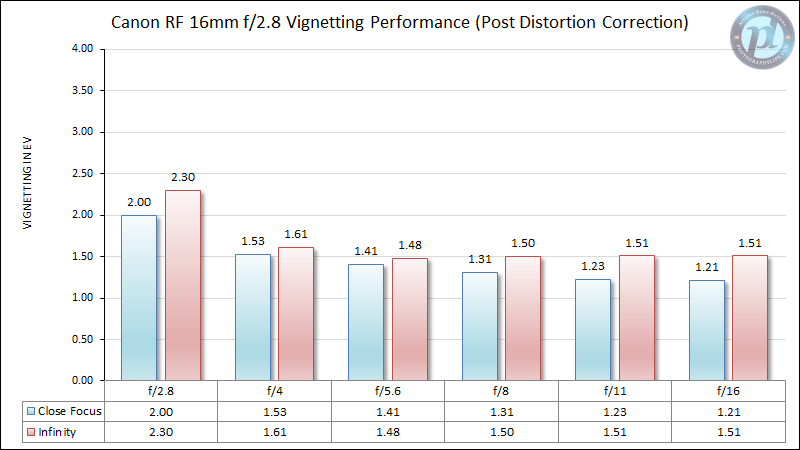
The maximum of 2.3 stops of vignetting is definitely high – you’ll need to correct it in a lot of your photos if you shoot at f/2.8. Also, the lens never reaches negligible vignetting levels, staying around 1.5 stops of vignetting even at the narrower apertures. As you focus more closely, things improve a bit, but only by about 1/3 stop at the most.
Here’s how the vignetting looks after correcting for distortion:

Lateral Chromatic Aberration
There is a Canon RF 16mm f/2.8 has a fair bit of chromatic aberration throughout the aperture range. Here’s the chart:

This is high enough that you’ll see chromatic aberration in a lot of your photos if you forget to enable corrections. While we occasionally see lenses with more CA than this, it’s definitely worse than average.
Here’s a real-world example of what happens when a high-contrast subject is in the corner of the frame. Let’s just ignore the fact that my tripod leg ended up in the photo here, too – or better yet, let’s pretend that it was deliberate!


Enabling the corrections in Lightroom works well, although there is still just a hint of lingering chromatic aberration that the software didn’t properly remove.
Sharpness
The Canon RF 16mm f/2.8 is not a very sharp lens, especially in the full-frame corners. Here’s how it measures in the lab:

The center is pretty good, and the midframes (APS-C corners) are at least reasonable. But the corners here are really bad, definitely in the bottom 10% of lenses that we’ve tested in Imatest.
For context, this is measured from a RAW file that did not have any distortion corrections applied, so the corner sharpness shown here would actually shrink a bit after stretching the corners when fixing distortion. Likewise, the portion of the RAW file examined for this test is where the corners will be after distortion correction – not the portion that’s cropped out after correcting distortion. All of that gave this lens the best chance to succeed. Unfortunately, the corners are just that bad.
I will say, however, that the copy of the Canon RF 16mm f/2.8 I tested had some noticeable decentering. I’ve requested a second copy of this lens to look for sample variation issues, and I will update this review with my findings once I’ve measured that copy in the lab. My prediction is that corner sharpness will be better on the second copy, although even a best-case scenario would put this lens well below average in corner sharpness.
By comparison, here’s how Canon’s RF 15-35mm f/2.8 L looks at its widest focal length of 15mm. It’s obviously a much more expensive lens and is far sharper; this is just for context. I’ll hold off on doing other lens comparisons until I’ve double checked the sharpness of the RF 16mm f/2.8 with a second copy.

Coma
Related to sharpness is coma, a lens aberration that makes points of light in the corner of a photo look like smears. Coma isn’t usually visible in everyday photography, but for something like Milky Way photography, it can be a factor. I was excited about the possibility of a portable 16mm f/2.8 lens for shooting the Milky Way, but how does it perform?
The crop shown after the image below is taken from the top-right corner of the Canon EOS R5 with the 16mm f/2.8. I didn’t do any resizing; it’s a direct excerpt from the image:
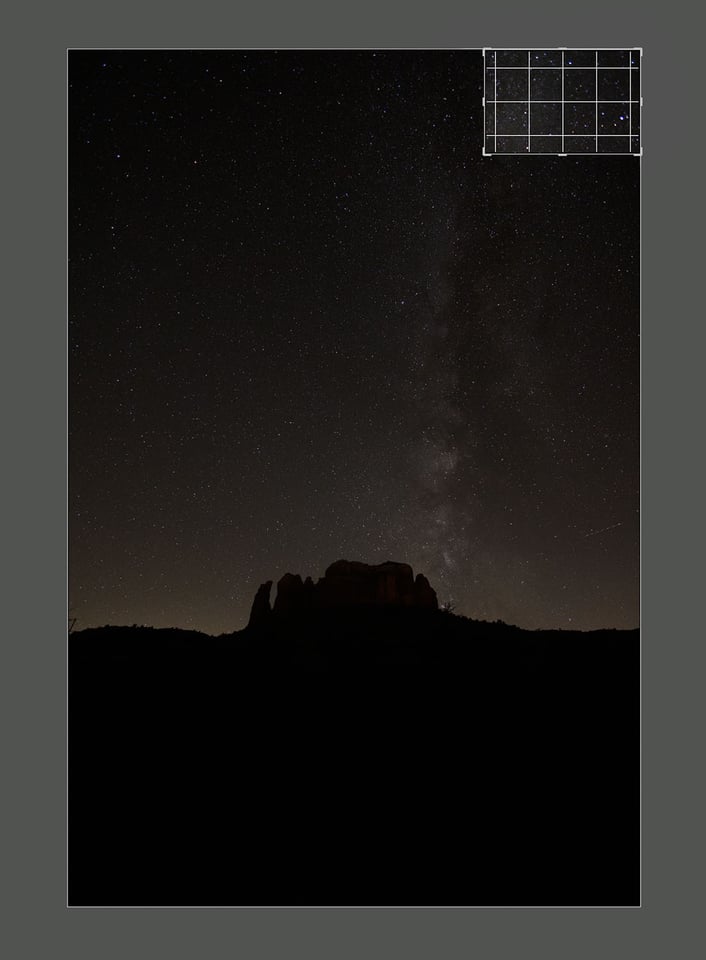

There’s definitely some coma here, and keep in mind that this is after distortion corrections have been applied, which jettisons the worst of the corners (although it does stretch what remains).
That said, let me point something out. The image above only looks bad – both soft and high in coma – near the top-right corner and corresponding edges. If you instead look in the direction of the image center, this crop actually doesn’t look too bad.
To me, this suggests that the Canon RF 16mm f/2.8 should be treated more as a pretty solid 18mm lens that can become a 16mm in a pinch if you don’t mind soft corners. Everywhere you look, from vignetting to sharpness, it’s really that last 3-5% of each corner that actually looks bad. The rest of the image, though far from best-in-class, is hardly bad.
In short, the coma result here is very revealing. Yes, it’s pretty noticeable in the extreme corners, but cropping even slightly makes things look substantially better.
Sunstars and Flare
Here’s one area where I have some mostly positive things to say about the Canon RF 16mm f/2.8 – it has good flare performance and sunstars in most images!
There is a bit less contrast and some rainbow-colored flare directly around the sun itself, at least in some photos, but the rest of the photo tends to look pretty good. I will say, it depends on the position of the sun. Here’s a worst-case and best-case photo of the same subject, the difference being a change in camera position that blocked the sun a little more. (No cloning or spot healing was applied to either photo):


That may seem like a big difference considering how similar the scene looks, but that was pretty typical of my experience with this lens. Here’s a similar, though less extreme example:


I would categorize the flare performance here as excellent when the sun is blocked just enough, but that there is a point where the sun can overwhelm the lens’s anti-flare coatings, and you get some noticeable issues.
In any case, even at its worst, the Canon RF 16mm f/2.8 is still better than a lot of ultra-wide lenses in terms of flare. At its best, its flare is almost best-in-class – and the well-defined 14-point sunstars are pretty nice.
Conclusioni:
The Canon RF 16mm f/2.8 is a flawed lens in many ways. The build quality and optical quality are both suboptimal. Even though it’s a pretty inexpensive lens, we’ve tested other sub-$300 lenses before that don’t have the same compromises as this one.
Yet at the same time, what I said near the start of this review is still completely true: I enjoyed using the Canon RF 16mm f/2.8 in the field and bringing it with me on some long hikes. It’s ultralight and so portable that it’s easy to forget you’re even carrying it. And, considering the price, it’s a great lens to bring to an environment where damage or theft are higher possibilities – even as a simple backup option to keep in your hotel room in case something happens to your primary kit.

None of that cancels out the lens’s issues, though. Here’s how I’d sum up the pros and cons.
Pros:
- Lightweight and portable design – more so than almost any other ultra-wide lens
- Good flare and sunstar performance
- The worst optical issues are confined to the extreme corners and can be cropped out
- Excellent price of $300, sometimes even on sale for $250
Cons:
- Extreme distortion, almost fisheye level
- Until you correct distortion, the tips of the corners are almost black at f/2.8
- Even after distortion correction, vignetting is still high
- Weak corner sharpness throughout the aperture range
- High levels of chromatic aberration
- No weather sealing + externally-focusing design is a bad combination in harsh weather
- Lens hood is not included
Unfortunately, the cons here definitely outweigh the pros. This makes the Canon RF 16mm f/2.8 a pretty specialized choice: great if you need the utmost in portability or low price, but substantially flawed if you need solid build quality or optical performance.
However, at least keep in mind what the coma tests on the previous page of this review revealed. The Canon RF 16mm f/2.8 is actually not bad if you crop your images to match a roughly 18mm lens. You’ll still find that most lenses are better, but cropping even by that much is enough to change this from “bad” to “okay” in my book. As I said on the previous page, maybe think of this as an 18mm lens that can be used as a 16mm in a pinch, and you won’t be so disappointed with it.
Given all that, I still think there’s a market for the Canon RF 16mm f/2.8. I’d probably get one myself as a Canon shooter if I felt the need to keep a backup ultra-wide in my bag, or if I needed the utmost light weight for a long-distance hike. However, in almost all of the usual ways to rate a lens, there is no way to sugar-coat the fact that the RF 16mm f/2.8 falls short.

I hope that you found this review of the Canon RF 16mm f/2.8 to be useful! If you want to buy the lens, you can thank us at The Photographers for the work that went into this review by using the links below:
| Canon RF 16mm f/2.8 STM | |
| Build Quality and Handling | 3 |
| Size and Weight | 5 |
| Sharpness Performance | 3 |
| Other Image Quality (Before Software Corrections) | 2 |
| Value | 4 |
| The Photographers Overall Rating | 3.3 |


